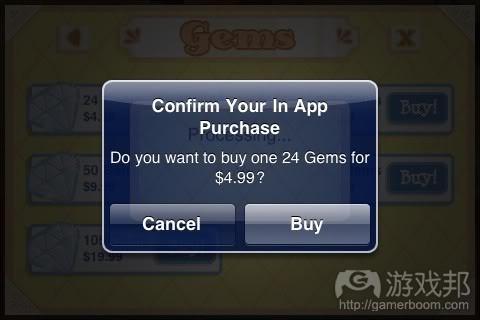分析免费游戏三种盈利渠道及其特点
作者:Softtalk Mobile
为何免费模式在今天看来如此重要?Gamesbrief博客主Nicholas Lovell就此分析了2011年美国苹果App Store中前100款畅销游戏,并发现其中57%是属于免费游戏,前10名排行中更有7款免费游戏。
通过适度免费发布游戏内容,开发者能够与用户建立起密切的关系,然后通过一些不同的方法从中盈利。以下我将列举出一些有效的途径:
广告:如果广告能够瞄准用户的利益,便能够同时造福终端用户和广告商。而开发者必须面对的一大挑战是如何设计一款既不会破坏游戏设置也能够同时适应广告内容的游戏。如果基于广告的应用能够提供更多沉浸式游戏设置,鼓励玩家反复回到游戏中,那么它便能够真正获得盈利。一次访问并没有多大价值,但是如果能够获得一群忠实的玩家,游戏便能够更有效地从中盈利。
销售升级版本:“免费试用”模式让玩家能够免费尝试一些删节版的游戏,并邀请他们付费购买完整版。虽然创造一款具有代表性的删节版游戏也不容易,但是益智游戏却非常适合这种模式。与广告相比,这种方法能够帮助游戏从每个玩家身上赚取更多利润,但是一大弊端是你一次只能从一名用户身上赚取收益,除非你创造的是一系列游戏,并尝试着鼓励玩家不断地为其消费。
销售付费内容:IAP(应用内置付费功能)便是游戏经济领域的一大创新。即尽管游戏采取了免费模式,但是玩家却可以通过消费购买游戏中的一些额外内容。有时候这些内容是指一个关卡,或者一些能够帮助增加游戏玩法价值的道具,并且通常来看,这些新内容都是关于玩家的游戏状态,例如一顶新帽子或者一橦新房子。
而执行这些收费模式必须符合你所使用的应用商店政策。例如,应用商店Intel AppUp的开发者计划提供了三个API,让开发者将其绑定自己旗下的Windows游戏以采用上述三种盈利模式:
*来自mOcean Mobile和Webmoblink的广告组件支持开发者免费将其绑定到应用程序中。
*使用In-App Upgrade API能够直接引导下载了试用版本的玩家前往应用商店中购买完整版游戏。
*In-App Unlocking API能够帮助游戏销售并解琐额外内容。你可以使用.csv文件在应用商店中上传内容简介,然后由应用商店处理交易活动,并批准这些应用解琐销售内容。
为打造一款成功的游戏,你不但要在游戏理念,游戏设计以及执行过程中贯穿创造性,同时也需要重视游戏商业模式中的创造性。如果iOS畅销游戏排行榜足够公正可信,那么免费模式就是一个值得依托的好归宿。
(本文为游戏邦/gamerboom.com编译,拒绝任何不保留版权的转载,如需转载请联系:游戏邦)
FEATURE: Making money with free games
by Softtalk Mobile
If you walk around a major city for long enough, you’ll stumble across someone giving away a free sample of something or other. Often it’s snack foods or toiletries.
I’ve sometimes wondered whether it’s possible to live off free samples, if you know where the distribution points are. You might end up with rotten teeth, but you could have very shiny hair.
There’s a sound rationale behind this generosity, of course. If you can get customers to try a product, they’re more likely to buy it. Also, if people try a great new product, they’re more likely to talk about it.
The same idea has been used in software for a long time, helped by the fact that software can be copied without incurring costs. Before the internet, people legitimately traded freeware or shareware software.
Businesses sprung up to distribute shareware by post or in cafes. People could try software with little financial risk, and then pay to register the software they liked.
Typically, features would be held back to encourage registration. Doom is the most famous example of a successful shareware product, but many programmers were able to sell software on a more modest level to people they couldn’t otherwise reach, thanks to shareware.
Why is this relevant today? Well, Nicholas Lovell of Gamesbrief has analysed the 100 top grossing apps of 2011 on Apple’s US app store, and found that 57% of them are free, including 7 of the top 10.
By giving away the app, developers are able to build rapport with customers, and then make money in a few different ways, which I would suggest are:
*Advertising: This can work well for both end users and advertisers if the advertising is well targeted to the user’s interests. The challenge is to design a game that can accommodate advertising without disrupting gameplay. Advertising-based apps can only really make money if they encourage immersive gameplay that brings people back repeatedly. A single visit isn’t worth much, but a base of loyal players can be monetised effectively.
*Selling app upgrades: The ‘free trial’ model gives people access to a cut down version of the game for free and invites them to pay for the full release. It can be tricky to create a representative cut-down version, but puzzle games can work particularly well in this format. This can often generate more revenue per player compared to advertising, but the drawback is that you can only make one sale per customer, unless you create a series of games and try to get players to buy into them all.
*Selling premium content: The in-app purchase has been a huge innovation in financing games. The idea here is that the game is given away, but people can buy additional content for it. Sometimes this content could be a level or something else that adds value to the gameplay, but often the new content is purely about status: a new hat that friends in the game can see, or a larger house for a character to live in.
Implementing these charging methods requires integration with the app store you’re using. For example, the Intel AppUp developer program offers three APIs that you can integrate with your Windows game to enable these revenue models:
*Advertising components from mOcean Mobile and Webmoblink are available for free integration with your app.
*The In-App Upgrade API can be used to direct players from a trial game to the store where they can purchase the full version.
?The In-App Unlocking API enables additional content to be sold and then unlocked from within an app. You upload the content descriptions to the app store using a .csv file, and the store handles the transactions and authorises the app to unlock the content.
To create a successful game, you need to exercise creativity in its concept, design and execution. But you also need increasingly to be creative with its business model. If the chart of top grossing apps on iOS is to be believed, free could be the way to go.(source:develop-online)









































